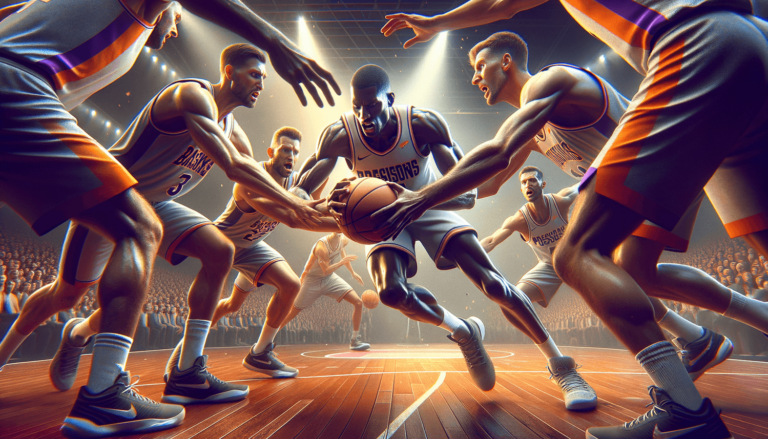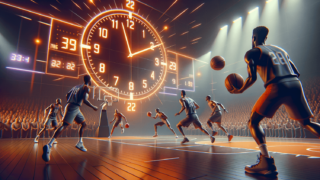
Basketball Possession Rule: How It’s Determined
Written by: Basketball Universe
Last updated:

The magic of basketball can be found in its fast-paced nature and the strategic chess-like game it often becomes. One critical element that navigates the intricate flow of a match is the possession rule, which ultimately determines which team gets to control the coveted orange leather ball. In this blog post, we dive into the fascinating world of basketball’s possession rule, uncovering its complexities and dispelling any lingering doubts you might have. So join us as we take an informative and exciting journey to explore this vital aspect of the game that will have you ‘dribbling’ with knowledge in no time!
Basketball Possession Rule: How It’s Determined
In basketball, possession determines which team controls the ball and is typically established through jump balls, rebounds, turnovers, steals, or out-of-bounds plays. The team that secures the ball gains possession, allowing them to initiate an offensive play. In international competition (FIBA) and the NBA, the possession arrow system replaces the jump ball after the initial game start, alternating possession between teams for situations such as jump ball violations, held balls, or double fouls. The possession arrow is toggled after each use, providing a fair and organized way to keep track of which team gets the ball next in these scenarios.
Jump into Jump Balls
Any discussion of basketball possession rules must begin with one of the most exciting and iconic aspects of the game: the jump ball. Occurring at the very start of the game, a jump ball is a visual spectacle showcasing the athleticism and agility of basketball players. The referee, positioned at center court, tosses the ball straight up into the air, and the tallest players from each team, known as centers, leap up and battle to tip the ball to a teammate. The moment when both centers reach the summit of their respective leaps, stretching their limbs to the fullest, vying for possession of the ball, is a sight to behold.
Understanding Alternating Possession
Once the initial jump ball is conducted, the possession arrow system comes into play. Used in international competitions regulated by FIBA and in the NBA, the possession arrow is a system designed to provide an equitable and systematic approach to determining which team gets the ball in specific situations. Instead of repeating the jump ball ritual any time there’s a jump ball violation, held ball, or double foul, the possession arrow points towards the team that gains the right to the ball, alternating possession between teams. After each use, the possession arrow is toggled, switching to the other team and providing a clear way to track which team gets the ball next.
Possession Arrow in Action
Let’s set the scene: two opposing players end up wrestling for the ball, both holding onto it with equal force. This scenario, known as a held ball, calls for the possession arrow system to be employed. The team indicated by the arrow as having the right to the subsequent possession gets to inbound the ball and initiate their offensive play. After this event, the possession arrow flips direction, pointing to the other team for future situations. Equitable and straightforward, the possession arrow system balances out possession opportunities among teams and adds a strategic element to the game.
Rebounds and Regaining Possession
The sound of the basketball clanging off the rim echoes throughout the arena. In basketball, this missed shot creates an opportunity for both teams to secure possession of the ball. The ensuing scrum, as players jockey for the best possible position underneath the hoop, is called rebounding. Offensive rebounding grants the team a second shot at scoring during the same possession, while a defensive rebound can halt the opponent’s scoring attempt, providing the defending team an opportunity to switch gears and move into an offensive play.
Tactics for Rebounding Success
Players looking to dominate the glass (grab rebounds) should keep the following tactics in mind. First, always remember the phrase “Box Out” – this means establishing a solid position between the opponent and the hoop by leaning into them, using your legs and upper body to maintain contact. Next, remain alert and anticipate the ball’s trajectory to get the edge. Finally, never forget to hone your vertical leap and timing, as these factors can contribute significantly to your rebounding prowess.
Turnovers: Interceptions and Steals
Now here’s a situation where basketball rules favor the quick-thinking and opportunistic players. Turnovers occur when the opposing team manages to gain possession of the ball during a defensive play. The two most common forms of turnovers are interceptions and steals. Interceptions happen when a defensive player snatches a pass intended for an offensive player, while steals involve taking the ball away directly from the person dribbling or attempting to shoot. Mastering the art of turnovers can not only frustrate the opposing team but also generate additional scoring opportunities for your team.
Acing the Art of Turnovers
Becoming an expert in causing turnovers involves several key elements. Firstly, studying the opponent’s play patterns is critical, as this can help you predict passes and intercept them with ease. Next, work on your agility and reaction time, which will prove beneficial in snatching the ball away from unsuspecting opponents. Finally, a steely resolve and concentration are integral to your success on this front, as they enable you to maintain focus and pounce at the right moment.
Out-of-Bounds: Treading the Line
An out-of-bounds situation in basketball occurs when the ball, or a player in possession of the ball, comes into contact with or crosses the boundary lines that demarcate the court. Being vigilant and fully aware of your positioning on the court is crucial, as the ball is awarded to the opposing team (the last team not to touch the ball) when an out-of-bounds event transpires. This rule means that quick reflexes and spatial awareness are vital, as a hair’s breadth can sometimes determine the course of a match.
Defensive Strategies for Out-of-Bounds Plays
At times, a team may find itself pushing the boundaries, both figuratively and literally. During these tense moments, defensive players should employ several strategies to limit the opponent’s scoring opportunities. First, apply pressure on the player receiving the inbound pass to make it more challenging to secure the ball. Secondly, look for ways to deflect passes to create confusion and potential turnovers. Finally, work as a cohesive defensive unit, employing effective communication and coordinated movements.
Throughout the course of a basketball game, possession is repeatedly gained, lost, and contested. From the initial jump ball to the game’s final seconds, understanding how the possession rule works adds another layer of excitement and strategy to this enthralling sport. Armed with this knowledge, players and spectators alike can fully appreciate the depth of tactics, skills, and planning that take place as teams strive to secure that crucial extra possession – and ultimately, victory. In a game where every point counts, knowing the ins and outs of basketball rules can make a world of difference. So, be it rebounding battles, high-leverage steals, or strategic out-of-bounds savvy, possession is the name of the game in basketball.
Violation Calls Impacting Possession
Basketball rules encompass various violation calls that can impact possession throughout the game. Remaining vigilant of these violations can help players on both sides of the court maximize their possession time and avoid handing the ball back to the opponent. Some critical violations that players should be mindful of include the following:
Shot Clock Violation
In basketball, a team has a limited amount of time to take a shot during each possession. In the NBA and FIBA, this time limit is set at 24 seconds, while college basketball in the United States follows a 30-second shot clock. The shot clock countdown resets when the ball hits the rim, but if a team fails to get a shot off within the allotted time, a shot clock violation is called, and possession is turned over to the opposing team. To avoid such a scenario, teams must be efficient in their offensive play and take well-timed shots within the allowed duration.
Traveling and Double Dribble
Traveling refers to the violation committed when a player holding the ball moves one or both of their feet illegally, often resulting in taking too many steps without dribbling. Double dribble, on the other hand, occurs when a player dribbles the ball with both hands simultaneously or starts dribbling again after the first dribble has ended. Both of these violations lead to a turnover, resulting in the opposing team regaining possession. To prevent such mistakes, players should be adept at dribbling, pivoting, and controlling the ball while maintaining legal contact and movement.
Offensive Fouls
While a variety of offensive fouls may be committed during a basketball game, the most notable is the charge, which occurs when an offensive player illegally contacts a defensive player who has established a legal guarding position. When an offensive foul is called, possession is awarded to the defending team. Players should commit to good sportsmanship and proper technique to avoid offensive fouls and not jeopardize their team’s possession.
Developing Personal Skills to Master Possession
Now that we’ve unraveled the intricacies of the basketball possession rule, let’s delve into some practical advice for aspiring players to help them excel in maintaining and securing possession throughout the game.
Ball Handling
Polishing your ball-handling skills is crucial in basketball, as it enables you to avoid turnovers, maintain possession, and ensure your team’s offensive plays run smoothly. The key is to strengthen your weaker hand and work on dribbling techniques that can effectively deceive your opponents. This skillset allows you to flourish in maintaining possession even in high-pressure situations.
Awareness and Decision-Making
Being aware of your position on the court, the time left on the shot clock, and the location of your teammates and opponents is essential in making sound decisions regarding possession. Cultivating an innate sense of timing and spatial awareness can positively impact how you use and maintain possession, ultimately improving your team’s chances of success.
Communication and Teamwork
An often-overlooked aspect of possession is communication between teammates. A well-synchronized team can make quick and accurate passes, reducing turnovers and maximizing possession time. Strong communication builds trust and allows teammates to create openings, exploit weak spots in the opponent’s defense, and efficiently use possession to their advantage.
Gaining a thorough understanding of the basketball possession rule and sharpening the skills necessary to keep possession can make you an invaluable asset to any team. For both players and fans, a deep appreciation for the possession rule and its impact on games unravels the strategic beauty of basketball and intensifies the thrill of closely contested matches.
FAQ Section: Basketball Possession Rule
Still have some burning questions about the basketball possession rule? No problem! This comprehensive FAQ section is here to address some of the most common questions related to possession in basketball. Let’s dive into these queries to enhance your understanding and appreciation of the game.
1. What happens if the tip-off in a jump ball goes out of bounds?
If the jump ball’s tip-off goes out of bounds, the team that did not touch it last is awarded possession. The team taking possession will inbound the ball from the sidelines.
2. How is possession determined in college basketball?
In college basketball, possession is determined following a similar system to the NBA and FIBA. After the initial jump ball, an alternating possession arrow is used to establish possession in situations like held balls, jump ball violations, and double fouls.
3. What is a held ball?
A held ball occurs when two opposing players wrestle for the ball, both holding onto it with equal force. In this situation, the possession arrow system is used to determine which team gets to inbound the ball and initiate their offensive play.
4. Can a defensive player cause a held ball?
Yes, a defensive player can cause a held ball by tying up the ball in the hands of an offensive player. In such a situation, the possession arrow system is employed to determine which team gains possession of the ball.
5. What is a turnover?
A turnover occurs when a team loses possession of the ball to the opposing team during a defensive play. This can happen through interceptions, steals, or various violations committed by the team that initially had possession.
6. What are some common violations that can cause a team to lose possession?
Common violations causing a team to lose possession include traveling, double dribble, shot clock violation, and offensive fouls.
7. How does a rebound impact possession?
A rebound is an opportunity for either team to secure possession of the ball after a missed shot. An offensive rebound allows the team to have another attempt at scoring, while a defensive rebound grants the defending team possession and the chance to switch to an offensive play.
8. How do out-of-bounds situations impact possession?
An out-of-bounds situation occurs when the ball, or a player in possession of the ball, comes into contact with or crosses the court’s boundary lines. When an out-of-bounds event occurs, possession is awarded to the opposing team, i.e., the last team not to touch the ball.
9. Can possession change due to a personal foul?
Yes, possession can change due to a personal foul, particularly offensive fouls. When an offensive foul is called, the defending team is awarded possession of the ball.
10. What is the importance of ball handling in relation to possession?
Ball handling is essential for maintaining and securing possession in basketball. Adequate ball-handling skills enable players to avoid turnovers, maintain control of the ball, and ensure that their team’s offensive plays run smoothly.
Featured Posts
- No pillar pages found.





